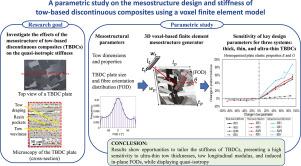基于体素的非连续复合材料细观结构设计和刚度参数化研究
IF 9.8
1区 材料科学
Q1 MATERIALS SCIENCE, COMPOSITES
引用次数: 0
摘要
基于纤维束的不连续复合材料(TBDCs)是由随机沉积的碳纤维束压缩成型而成的。因此,可以实现具有高刚度和强度的准各向同性响应,同时减少浪费,从而与层压复合材料竞争。此外,具有超薄拖带(0.02 mm)的新型tbdc扩展了设计空间,并为薄壁结构提供了机会。然而,复杂的三维细观结构参数已经被证明会影响它们的刚度,例如拖束/板形态、树脂袋含量、拖束波浪度和拖束方向分布,这仍然是它们建模和设计的挑战。本文利用作者开发并验证的一种新型基于体素的tbdc有限元细观结构生成器,探索细观结构设计修改对其刚度的意义。在一个扩展的设计空间中进行了参数化研究,包括厚、薄和超薄束系统的基线,以研究重要参数的影响,如束模量(高达超高模量)、束和板尺寸(注意薄板)以及优选的平面内纤维取向分布。并将数值模型与短纤维模型和等效层合板的意义进行了比较。结果比较了它们对每个TBDC材料系统的灵敏度,显示了优化的机会。最后,根据刚度击倒、准各向同性行为、弹性性能的统计变异性和临界最小板尺寸确定设计约束。本文章由计算机程序翻译,如有差异,请以英文原文为准。

A parametric study on the mesostructure design and stiffness of tow-based discontinuous composites using a voxel finite element model
Tow-Based Discontinuous Composites (TBDCs) are manufactured by compression moulding of randomly deposited carbon fibre tows. As such, a quasi-isotropic response with high stiffness and strength can be achieved, while reducing waste, thus competing with laminated composites. Moreover, novel TBDCs with ultra-thin tows (0.02 mm) have expanded the design space and opened opportunities for thin-walled structures. However, complex 3D mesostructural parameters have been demonstrated to impact their stiffness, such as tow/plate morphology, resin pocket content, tow waviness, and tow orientation distributions, which remain a challenge for their modelling and design. The present work exploits a novel voxel-based finite element mesostructure generator for TBDCs developed and validated by the authors to explore the significance of mesostructural design modifications on their stiffness. A parametric study over an extended design space including baselines of thick, thin, and ultra-thin tow systems, is conducted to investigate the effect of important parameters such as the tow moduli (up to ultra-high modulus), tow and plate dimensions (with attention to thin plates), and preferred in-plane fibre orientation distributions. Also, the significance of the numerical model is compared with short-fibre models and equivalent laminates. The results compare their sensitivity for each TBDC material system, showing opportunities for optimisation. Finally, design constraints are identified in terms of the stiffness knockdown, quasi-isotropic behaviour, statistical variability of the elastic properties, and critical minimum plate dimensions.
求助全文
通过发布文献求助,成功后即可免费获取论文全文。
去求助
来源期刊

Composites Science and Technology
工程技术-材料科学:复合
CiteScore
16.20
自引率
9.90%
发文量
611
审稿时长
33 days
期刊介绍:
Composites Science and Technology publishes refereed original articles on the fundamental and applied science of engineering composites. The focus of this journal is on polymeric matrix composites with reinforcements/fillers ranging from nano- to macro-scale. CSTE encourages manuscripts reporting unique, innovative contributions to the physics, chemistry, materials science and applied mechanics aspects of advanced composites.
Besides traditional fiber reinforced composites, novel composites with significant potential for engineering applications are encouraged.
 求助内容:
求助内容: 应助结果提醒方式:
应助结果提醒方式:


